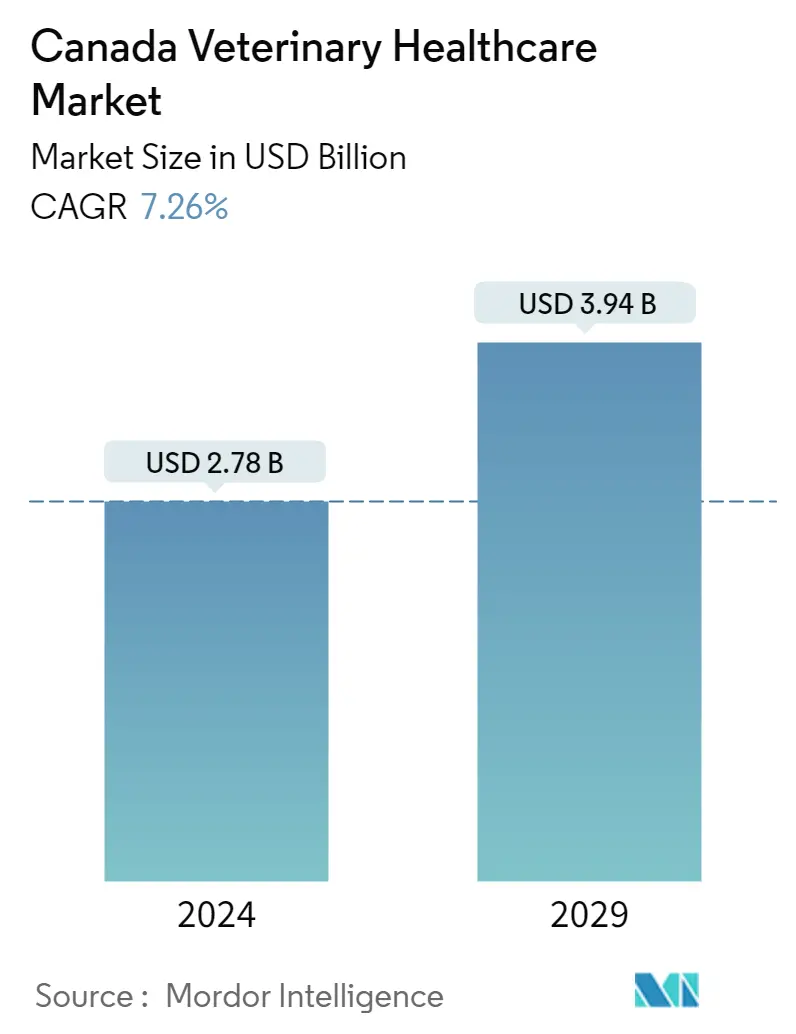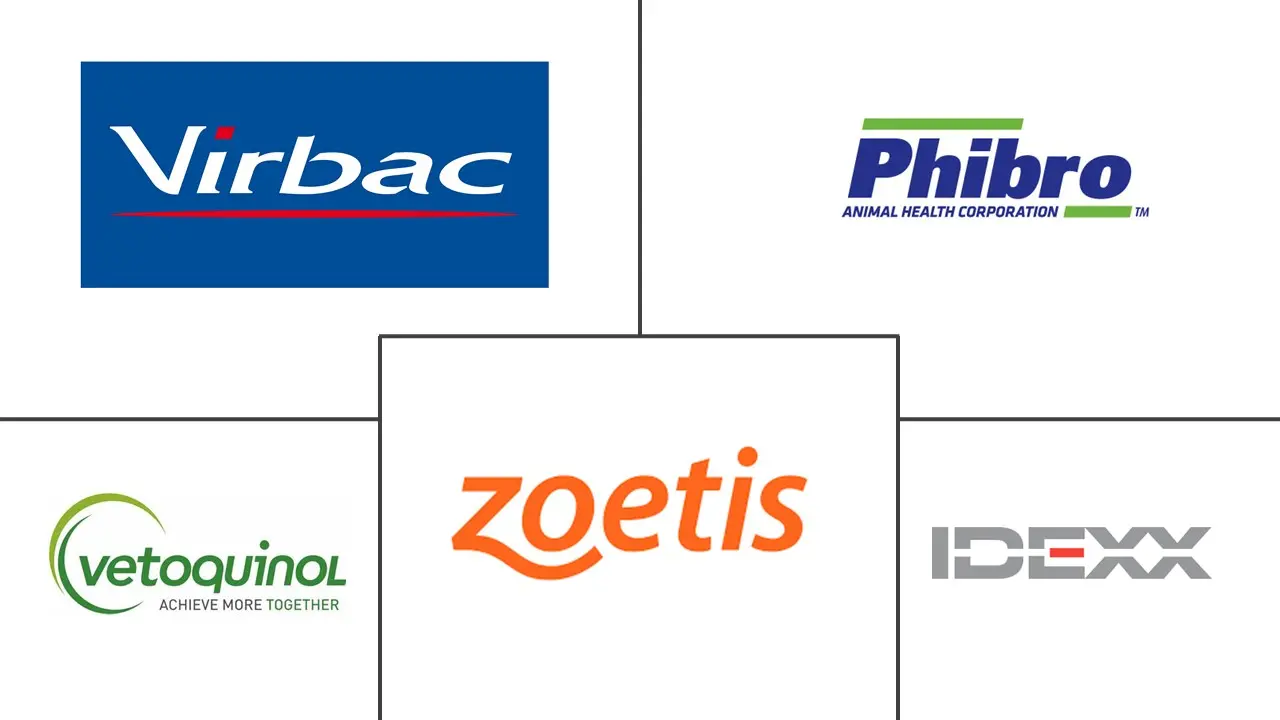Market Size of Canada Veterinary Healthcare Industry

| Study Period | 2019 - 2029 |
| Base Year For Estimation | 2023 |
| Market Size (2024) | USD 2.78 Billion |
| Market Size (2029) | USD 3.94 Billion |
| CAGR (2024 - 2029) | 7.26 % |
| Market Concentration | Medium |
Major Players
*Disclaimer: Major Players sorted in no particular order |
Canada Animal Health Care Market Analysis
The Canada Veterinary Healthcare Market size is estimated at USD 2.78 billion in 2024, and is expected to reach USD 3.94 billion by 2029, growing at a CAGR of 7.26% during the forecast period (2024-2029).
The COVID-19 pandemic had a significant impact on the market. Extensive information is available regarding animal coronavirus concerning its evolution and pathophysiology. According to the Government of Canada, in June 2022, different animal species tested positive for the virus that causes COVID-19 during the pandemic. Furthermore, according to the Canadian Food Inspection Agency, 2022, the COVID-19 pandemic was exacerbated by the intra-pandemic emergence of novel variants of concern (VOCs) and multiple ongoing outbreaks of highly pathogenic avian influenza (HPAI) in the country. The development, transmission, and impact of zoonotic illnesses are influenced by intersecting biological, ecological, and socioecological processes, which propel the market. However, post-pandemic pet care has increased in Canada. For instance, according to Canadian Animal Health Institute data updated in April 2022, between 2020-2022, the Canadian dog and cat populations continued to grow, increasing from 7.7 million to 7.9 million for dogs and 8.1 million to 8.5 million for cats. Furthermore, there is a 3% increase in the number of cats that visited a veterinary clinic in the previous 12 months, from 58% in 2020 to 61% in 2022. Thus, the increase in veterinary clinic visits is expected to drive the market during the forecast period.
The Canadian veterinary healthcare market is primarily driven by increasing animal adoption, the rising burden of animal diseases, and increased spending on animal health. For instance, according to an article published by Osler, Hoskin & Harcourt LLP, in June 2021, 18% of Canadian pet owners acquired their companion during the pandemic. The Canadian population has high levels of awareness regarding companion animals and livestock, resulting in the increasing adoption of these animals for social well-being and a healthy lifestyle, eventually driving the market's growth.
In addition, there has been increasing demand for analgesics, antibiotics, anti-inflammatory drugs, and anesthetics, followed by biologics and vaccines for veterinary services such as dogs and cats. According to MDPI, in September 2022, increased use of Tri-Solfen with NSAIDs significantly reduces pain and suffering in livestock, with enhanced healing of FMD lesions, reduced viral loads from Orf infections in lambs, and diminished necessity of 'antibiotic cover,' assisting antimicrobial-resistance (AMR) stewardship. The increased demand and advantage
of biologics and vaccines for veterinary services are supposed to drive the market.
Thus, the abovementioned factors are impacting the market growth of the Canada Veterinary Healthcare systems market. However, counterfeit medicines and the high costs of animal testing and veterinary services are expected to restrain the market growth.
Canada Animal Health Care Industry Segmentation
The veterinary healthcare market comprises therapeutic and diagnostic products and solutions for companion and farm animals. Companion animals can be tamed or adopted for companionship or as house/office guards, and farm animals are raised for meat and milk-based products. Companion animals include canines, felines, and equines. Farm animals include bovine, poultry, and porcine.
Canada Veterinary Healthcare Market is Segmented by Product (Therapeutics (Vaccines, Parasiticides, Anti-infectives, Medical Feed Additive, and Other Therapeutics) and Diagnostics (Immunodiagnostic Tests, Molecular Diagnostics, Diagnostic Imaging, Clinical Chemistry, and Other Diagnostics) and Animal Type (Dogs and Cats, Horses, Ruminants, Swine, Poultry, and Other Animal Types). The market report also covers the estimated market sizes and trends for Canada. The report offers the value (in USD million) for the above segments.
| By Product | |||||||
| |||||||
|
| By Animal Type | |
| Dogs and Cats | |
| Horses | |
| Ruminants | |
| Swine | |
| Poultry | |
| Other Animal Types |
Canada Veterinary Healthcare Market Size Summary
The Canadian veterinary healthcare market is poised for significant growth, driven by increasing pet adoption, heightened awareness of animal health, and rising expenditures on animal care. The market's expansion is further supported by the growing demand for veterinary services, including analgesics, antibiotics, and vaccines, which are essential for maintaining the health of companion animals and livestock. The post-pandemic surge in pet care, evidenced by the rising number of veterinary clinic visits, has also contributed to the market's upward trajectory. Despite challenges such as counterfeit medicines and the high costs associated with veterinary services, the market is expected to benefit from regulatory oversight ensuring the safety and efficacy of veterinary biologics, including vaccines.
The market landscape is characterized by a surge in pet insurance adoption and an increase in pet ownership, which are anticipated to drive segmental growth. The Canadian veterinary healthcare industry has seen notable mergers and acquisitions, with major players like Bayer Healthcare, Boehringer Ingelheim, and Zoetis Animal Healthcare leading the charge. Recent advancements in veterinary medicine, coupled with new product launches, are expected to further propel market growth. Initiatives to promote veterinary care and the increasing number of pets requiring vaccinations are also key factors contributing to the market's expansion over the forecast period.
Canada Veterinary Healthcare Market Size - Table of Contents
-
1. MARKET DYNAMICS
-
1.1 Market Overview
-
1.2 Market Drivers
-
1.2.1 Increase in Ownership of Pet Animals
-
1.2.2 Advanced Technology Leading to Innovations in Animal Healthcare
-
1.2.3 Risk of Emerging Zoonosis
-
-
1.3 Market Restraints
-
1.3.1 Use of Counterfeit Medicines
-
1.3.2 High Costs of Animal Testing and Veterinary Services
-
-
1.4 Porter's Five Forces Analysis
-
1.4.1 Threat of New Entrants
-
1.4.2 Bargaining Power of Buyers/Consumers
-
1.4.3 Bargaining Power of Suppliers
-
1.4.4 Threat of Substitute Products
-
1.4.5 Intensity of Competitive Rivalry
-
-
-
2. MARKET SEGMENTATION (Market Size by Value in USD Million)
-
2.1 By Product
-
2.1.1 By Therapeutics
-
2.1.1.1 Vaccines
-
2.1.1.2 Parasiticides
-
2.1.1.3 Anti-infectives
-
2.1.1.4 Medical Feed Additives
-
2.1.1.5 Other Therapeutics
-
-
2.1.2 By Diagnostics
-
2.1.2.1 Immunodiagnostic Tests
-
2.1.2.2 Molecular Diagnostics
-
2.1.2.3 Diagnostic Imaging
-
2.1.2.4 Clinical Chemistry
-
2.1.2.5 Other Diagnostics
-
-
-
2.2 By Animal Type
-
2.2.1 Dogs and Cats
-
2.2.2 Horses
-
2.2.3 Ruminants
-
2.2.4 Swine
-
2.2.5 Poultry
-
2.2.6 Other Animal Types
-
-
Canada Veterinary Healthcare Market Size FAQs
How big is the Canada Veterinary Healthcare Market?
The Canada Veterinary Healthcare Market size is expected to reach USD 2.78 billion in 2024 and grow at a CAGR of 7.26% to reach USD 3.94 billion by 2029.
What is the current Canada Veterinary Healthcare Market size?
In 2024, the Canada Veterinary Healthcare Market size is expected to reach USD 2.78 billion.

